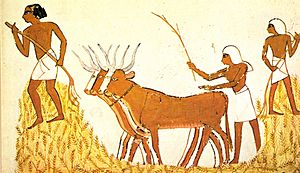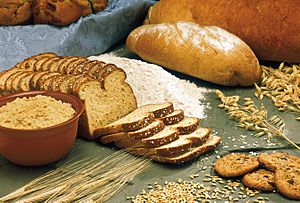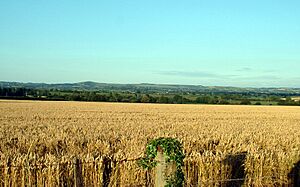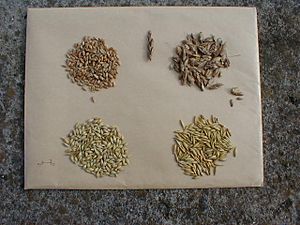Cereal facts for kids

Cereal usually means a type of grass grown for its edible grains. These grains are a big part of what we eat.
Many people enjoy breakfast cereal as a common breakfast meal. This kind of cereal is made from grain. In the United States, it's often eaten with milk. Breakfast cereals are usually sweetened with sugar, syrup, or fruit. There are many different kinds, like Cheerios, Kellogg's, and Cocoa Puffs. While some are made for adults, many breakfast cereals are created especially for kids. Some adult cereals are even made for diets or other health reasons.
The word "cereal" comes from 'Ceres', who was the Roman goddess of harvest and farming. In the United Kingdom and Ireland, grains are often called corn. But in the United States, Canada, Australia, and New Zealand, corn means maize.
Contents
The Story of Cereal
In the 1800s, Americans often ate a lot of meat for breakfast. They usually didn't eat much grain or fiber. But then, people who wanted to eat healthier started to push for better breakfast foods.
This led to the creation of Granula in 1863. It was the first breakfast cereal ever made. The name Granula comes from granulates, which means it was made from grain. This early cereal had hard pieces made from bran. Bran is the outer layer of a grain, which is usually removed when making flour. To eat Granula, you had to soak it in water overnight. Just pouring milk over it wasn't enough!
The cereals we eat today came from this health movement that started in the 1860s. Two men, C.W. Post and W. K. Kellogg, were inspired by thin baked dough served to patients in hospitals. They both started their own companies, naming them after themselves.
How Cereal Plants Grow
Even though each type of cereal plant is a bit different, they are all grown in similar ways. Most cereals are annual plants. This means you plant them once, and they give you one harvest.
Some cereals are "cool-season" plants. These include wheat, rye, triticale, oats, barley, and spelt. They are strong plants that grow well in mild weather. They stop growing when it gets too hot, usually around 30°C. Other cereals are "warm-season" plants. These are more delicate and prefer hot weather. Barley and rye are the toughest cereals. They can even survive winter in very cold places like the subarctic and Siberia. Many cool-season cereals are also grown in tropical areas. However, some only grow in cooler highlands, where farmers might be able to harvest crops multiple times a year.
In recent years, people have become interested in perennial grain plants. These plants grow back year after year without needing to be replanted. This is good because it helps stop soil from washing away and means farmers might need less fertilizer. It could also lower costs for farmers. Research is still new, but The Land Institute in Kansas has created some types that produce a good amount of grain.
Planting Cereal Grains
Warm-season cereals are grown in tropical lowlands all year round. In places with changing seasons, they are grown during the time when there is no frost. Rice is often grown in fields that are flooded with water. However, some types of rice can grow on dry land. Other warm-climate cereals, like sorghum, are good at growing in dry places.
Cool-season cereals grow well in mild climates. Most types of these plants are either "winter" or "spring" varieties. Winter varieties are planted in the autumn. They sprout and grow leaves, then become inactive during winter. They start growing again in spring and are ready to harvest in late spring or early summer. This way of farming uses water well and frees up the land for another crop early in the growing season.
Winter varieties need to be exposed to cold temperatures for a certain time before they can flower. This is called vernalization. If winters are too warm for this process, or too cold for the plant to survive, farmers plant spring varieties. Spring cereals are planted in early spring. They grow and are ready to harvest later that same summer, without needing cold weather first. Spring cereals usually need more watering and produce less grain than winter cereals.
Harvesting the Crop

Once cereal plants have grown their seeds, their life cycle is complete. The plants turn brown, dry out, and die. As soon as the plants and their seeds are dry enough, harvesting can begin.
In developed countries, machines are always used to harvest cereal crops. A combine harvester is typically used. This machine cuts the plant, separates the grain (called threshing), and cleans it (called winnowing) all in one pass across the field. In developing countries, different harvesting methods are used. These depend on how much labor costs. Methods range from combines to hand tools like the scythe or grain cradle.
If a crop is harvested when the weather is humid, the grain might not dry enough in the field. This can cause it to spoil during storage. In this case, the grain is sent to a special facility. There, artificial heat is used to dry it.
In North America, farmers often take their freshly harvested grain to a grain elevator. This is a large storage building that collects crops from many farmers. The farmer can sell the grain right away. Or, they can keep ownership of their share of grain in the storage facility to sell later. Storage places must be protected from small pests, rodents, and birds.
Related pages
Images for kids
-
Wheat Field in Behbahan, Iran
See also
 In Spanish: Cereal para niños
In Spanish: Cereal para niños







